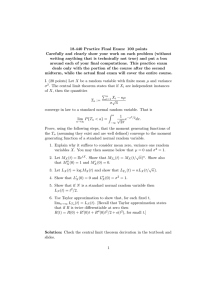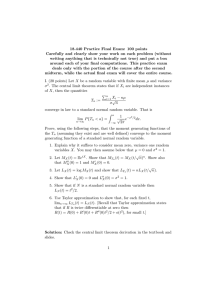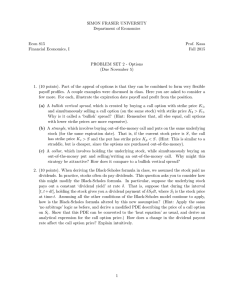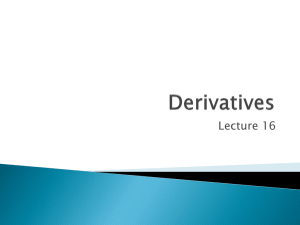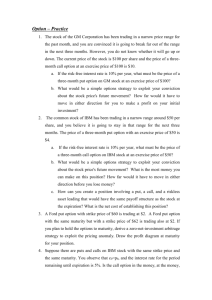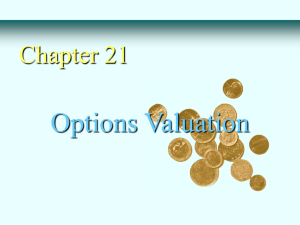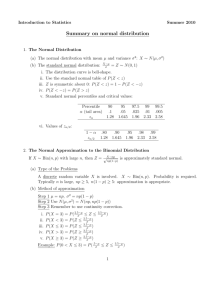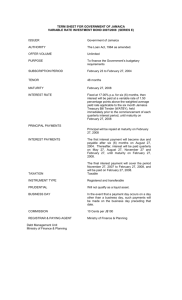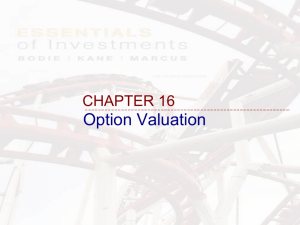Practice problems for Lecture 4. Answers. 1. Black
advertisement
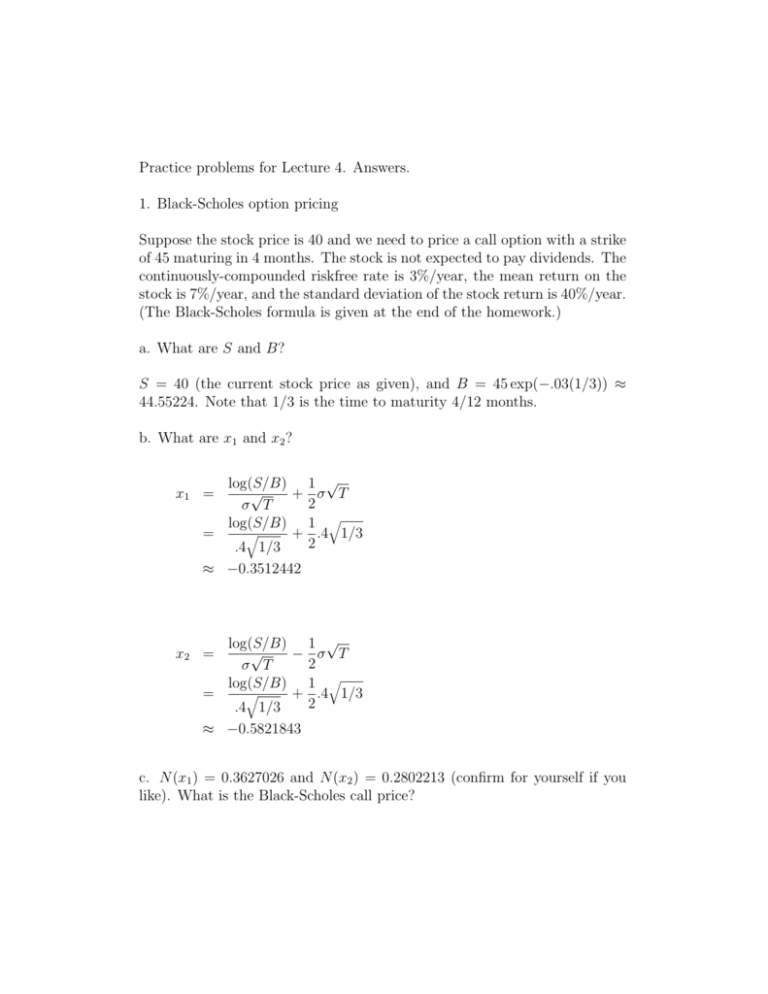
Practice problems for Lecture 4. Answers. 1. Black-Scholes option pricing Suppose the stock price is 40 and we need to price a call option with a strike of 45 maturing in 4 months. The stock is not expected to pay dividends. The continuously-compounded riskfree rate is 3%/year, the mean return on the stock is 7%/year, and the standard deviation of the stock return is 40%/year. (The Black-Scholes formula is given at the end of the homework.) a. What are S and B? S = 40 (the current stock price as given), and B = 45 exp(−.03(1/3)) ≈ 44.55224. Note that 1/3 is the time to maturity 4/12 months. b. What are x1 and x2 ? log(S/B) 1 √ √ + σ T 2 σ T log(S/B) 1 q q = + .4 1/3 2 .4 1/3 x1 = ≈ −0.3512442 log(S/B) 1 √ √ − σ T 2 σ T log(S/B) 1 q q = + .4 1/3 2 .4 1/3 x2 = ≈ −0.5821843 c. N (x1 ) = 0.3627026 and N (x2 ) = 0.2802213 (confirm for yourself if you like). What is the Black-Scholes call price? C = SN (x1 ) − BN (x2 ) ≈ 40 × 0.3627026 − 44.55224 × 0.2802213 ≈ 2.023617 d. What is the Black-Scholes price for the European put with the same strike and maturity? By put-call parity, S + P = B + C, and therefore the price is P = B+C −S ≈ 44.55224 + 2.023617 − 40 ≈ 6.57586 e. Conceptual question: Since the put option is worth more alive than if exercised now (45 − 40 = 5 < 6.57586), can we conclude that an American version of the put is worth the same as the European put? No. The value today is enhanced by our option to exercise an American option between now and maturity. 2. Approximation As noted in class, for near-the-money call options, a good approximation to the option price is S−B S+B √ + .4 σ T 2 2 where S is the stock price, B the present value of receiving the strike at maturity, σ is the local standard deviation, and T is the time to maturity. 2 Consider an at-the-money call option that is one week to maturity on a stock with a local standard deviation of 35%/year. If the stock is selling for $50 and the continuously-compounded riskfree rate is 1%/year, then the BlackScholes call option price is $0.9727852. a. What is the call price from the approximate formula? T = 1/52, S = 50, B = 50 exp(−.01 × 1/52) ≈ 49.9903855, σ = .35 S−B S+B √ + .4 σ T 2 2 s 50 + 49.9903855 50 − 49.9903855 1 + .4 .35 ≈ 2 2 52 ≈ .9754392 C ≈ b. What is the error from using the approximate price? .9754392 − .9727852 ≈ $0.00265 (about a quarter of a cent) c. What is the corresponding European put price using the approximation? (Use put-call parity. The Black-Scholes put price is $0.963.) By put-call parity, P = B+C −S, so the put price is 49.9903855+0.9754392− 50 ≈ $0.9658247 Useful Formula The Black-Scholes call price is C(S, T ) = SN (x1 ) − BN (x2 ), 3 where S is the stock price, N (·) is the cumulative normal distribution function, T is time-to-maturity, B is the bond price Xe−rf T , rf is the continuouslycompounded riskfree rate, σ is the standard deviation of stock returns, x1 = log(S/B) 1 √ √ + σ T, 2 σ T x2 = log(S/B) 1 √ √ − σ T. 2 σ T and Note that log(·) is the natural logorithm. 4
